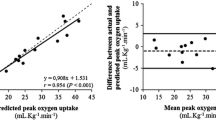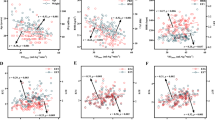Abstract
In this study we aimed to elucidate the validity and usefulness of the oxygen uptake efficiency slope (OUES) in the evaluation of adult cardiac patients. Cardiopulmonary exercise tests were performed on a treadmill by 50 adult patients with chronic heart failure. The OUES was calculated from data for the first 75%, 90%, and 100% of exercise duration. The OUES is derived from the following equation: V˙O2=a× logV˙ E+b, where V˙O2 is oxygen uptake (ml/kg/min), V˙ E is minute ventilation (l/kg/min), and the constant “a” represents OUES. We also determined the ventilatory anaerobic threshold (VAT). The correlation coefficient of the logarithmic curve-fitting model was [mean (SD)] 0.986 (0.009). The OUES could be used to discriminate effectively between New York Heart Association functional classes (P < 0.001). OUES and maximum V˙O2 were significantly correlated (r=0.78, P < 0.01). Agreement between the OUES values for the first 90%, 75%, and 100% of the exercise was excellent (intraclass correlation coefficient = 0.99). Our results suggest that OUES is applicable to adult cardiac patients as an objective, effort-independent estimation of cardiorespiratory functional reserve.
Similar content being viewed by others
Author information
Authors and Affiliations
Additional information
Accepted: 7 September 1998
Rights and permissions
About this article
Cite this article
Baba, R., Tsuyuki, K., Kimura, Y. et al. Oxygen uptake efficiency slope as a useful measure of cardiorespiratory functional reserve in adult cardiac patients. Eur J Appl Physiol 80, 397–401 (1999). https://doi.org/10.1007/s004210050610
Issue Date:
DOI: https://doi.org/10.1007/s004210050610




